|
◆《History
development》
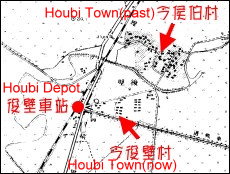 Houbi
Town was developed as early as the Ming-Cheng Period. In the east
lies Chia Chie Village (Ben-Shie) where Ming-Cheng was established.
It is the place where Ming-Cheng gave lands to military households
and used them as agrarian colonies (tuntian). Shang Chia Dong and
Hsia Chia Dong emerged as early as the Ming-Cheng Period. After the
Ching Dynasty, the Han Chinese cultivated along Dao-Fong-Nei-Hai-Suo
of Pachang Creek all the way up to Jishuei River (Driving Creek).
Hsia Chia Dong is considered one of the development strongholds.
According to Chulo Koanchi, (Topographical and Historical
Descriptions of Chulo) commercial vessels gathered and loaded
5-grain goods to be transported by sea to Hsia Chia Dong.” At the
time, a patrol point was setup in Hsia Chia Dong with 1 military
officer (Ba-Tzung), and 85 infantrymen. Houbi
Town was developed as early as the Ming-Cheng Period. In the east
lies Chia Chie Village (Ben-Shie) where Ming-Cheng was established.
It is the place where Ming-Cheng gave lands to military households
and used them as agrarian colonies (tuntian). Shang Chia Dong and
Hsia Chia Dong emerged as early as the Ming-Cheng Period. After the
Ching Dynasty, the Han Chinese cultivated along Dao-Fong-Nei-Hai-Suo
of Pachang Creek all the way up to Jishuei River (Driving Creek).
Hsia Chia Dong is considered one of the development strongholds.
According to Chulo Koanchi, (Topographical and Historical
Descriptions of Chulo) commercial vessels gathered and loaded
5-grain goods to be transported by sea to Hsia Chia Dong.” At the
time, a patrol point was setup in Hsia Chia Dong with 1 military
officer (Ba-Tzung), and 85 infantrymen. 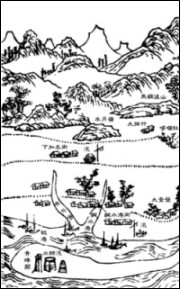 Toward
the end years of Kang-Shi, Hsia Chia Dong Street was setup inside
Hsia Chia Dong Village. It was the place for military officers and
civilians to render rentals and food supplies. With the rise of
Dian-Zii-Kou Street (Baihe), Hsia Jia Dong Street gradually
downgraded. Toward
the end years of Kang-Shi, Hsia Chia Dong Street was setup inside
Hsia Chia Dong Village. It was the place for military officers and
civilians to render rentals and food supplies. With the rise of
Dian-Zii-Kou Street (Baihe), Hsia Jia Dong Street gradually
downgraded.
From the end of Ching Dynasty to the beginning of the Japanese
colonial period, the development focus was shifted to Chin Liao.
“Chin Liao Credit Cooperative” (Forerunner of Houbi Farmers’
Association) established in 1917 in Chin Liao is a typical example
of which. Later, the Japanese setup Cross-island highway and
cross-island railway that passed by Houbi Liao. During which time, 4
country gentries Huang Mo, Huang Dong, Huang Cheng Lung, and Huang
Cheng De brothers believed Houbi Train Station to possess great
development potentials. In 1924, they moved to the southern part of
the station, setup “Huang Cheng Hsing Joint Venture Company”, and
began business operation. Land cultivators along the seacoast were
recruited to engage in land tillage. Houbi Station gradually
developed and prospered. After Taiwan retrocession, the station and
nearby areas formed a village and became the administrative center
of Houbi Town.
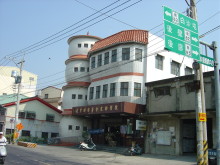 |
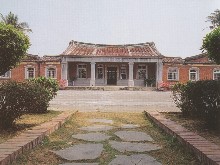 |
|
Houbi Farmers’ Association
(Chin Liao Office) is the first
financial
institution in Houbi Town. |
Houbi Village was developed
by
the Huangs. The picture
shows the old house
of the
Huangs in Houbi-extracted. |
◆《Religious
practice of villagers》
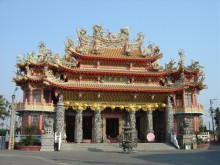 In
a typical rural village in Taiwan, there is at least one temple in
the village. It is a place to enshrine traditional gods. The temples
are collectively included as part of the large sacrificial offering
circle. Houbi Town also follows similar pattern. Tai-An Temple is
located in Hsia Jia Dong, which is the religious center of Houbi
Town. It enshrines Matzu (Goddess of Sea). According to
“She-Jiao-Lun-Liu-Chu-Shih Pillar” it states that The Tai-An Temple
Matzu religious circle formed no later than the Tong-Zhi Period.
Areas under control included Houbi, Bai He, and Hsin-Ying. The 36
villages had a common religious faith. Currently, this number
increased to 60. The temples in existence were reconstructed in
1992, which cost over NT$130,000,000. In
a typical rural village in Taiwan, there is at least one temple in
the village. It is a place to enshrine traditional gods. The temples
are collectively included as part of the large sacrificial offering
circle. Houbi Town also follows similar pattern. Tai-An Temple is
located in Hsia Jia Dong, which is the religious center of Houbi
Town. It enshrines Matzu (Goddess of Sea). According to
“She-Jiao-Lun-Liu-Chu-Shih Pillar” it states that The Tai-An Temple
Matzu religious circle formed no later than the Tong-Zhi Period.
Areas under control included Houbi, Bai He, and Hsin-Ying. The 36
villages had a common religious faith. Currently, this number
increased to 60. The temples in existence were reconstructed in
1992, which cost over NT$130,000,000.
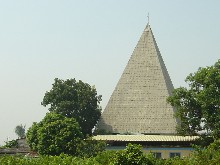 Other
than traditional religious faith, foreign religions such as
Christianity and Catholicism were also introduced in Houbi Town.
Several churches were constructed, but as these religious practices
faded, many of these churches are now left unused with church
services are no longer held. Among the church architectures, “Hou
Chin Liao Holy Cross Church” adjacent to Chin Liao Elementary School
is the most famous of all. It was designed by German Pulitz
Architecture Award Winner, Gottfried Bohm. The pyramid styled holy
tenoke is the most eye-catching part of the architectural design.
Legend has it that the design was inspired by hay heaps on local
rice fields. Other
than traditional religious faith, foreign religions such as
Christianity and Catholicism were also introduced in Houbi Town.
Several churches were constructed, but as these religious practices
faded, many of these churches are now left unused with church
services are no longer held. Among the church architectures, “Hou
Chin Liao Holy Cross Church” adjacent to Chin Liao Elementary School
is the most famous of all. It was designed by German Pulitz
Architecture Award Winner, Gottfried Bohm. The pyramid styled holy
tenoke is the most eye-catching part of the architectural design.
Legend has it that the design was inspired by hay heaps on local
rice fields.
|